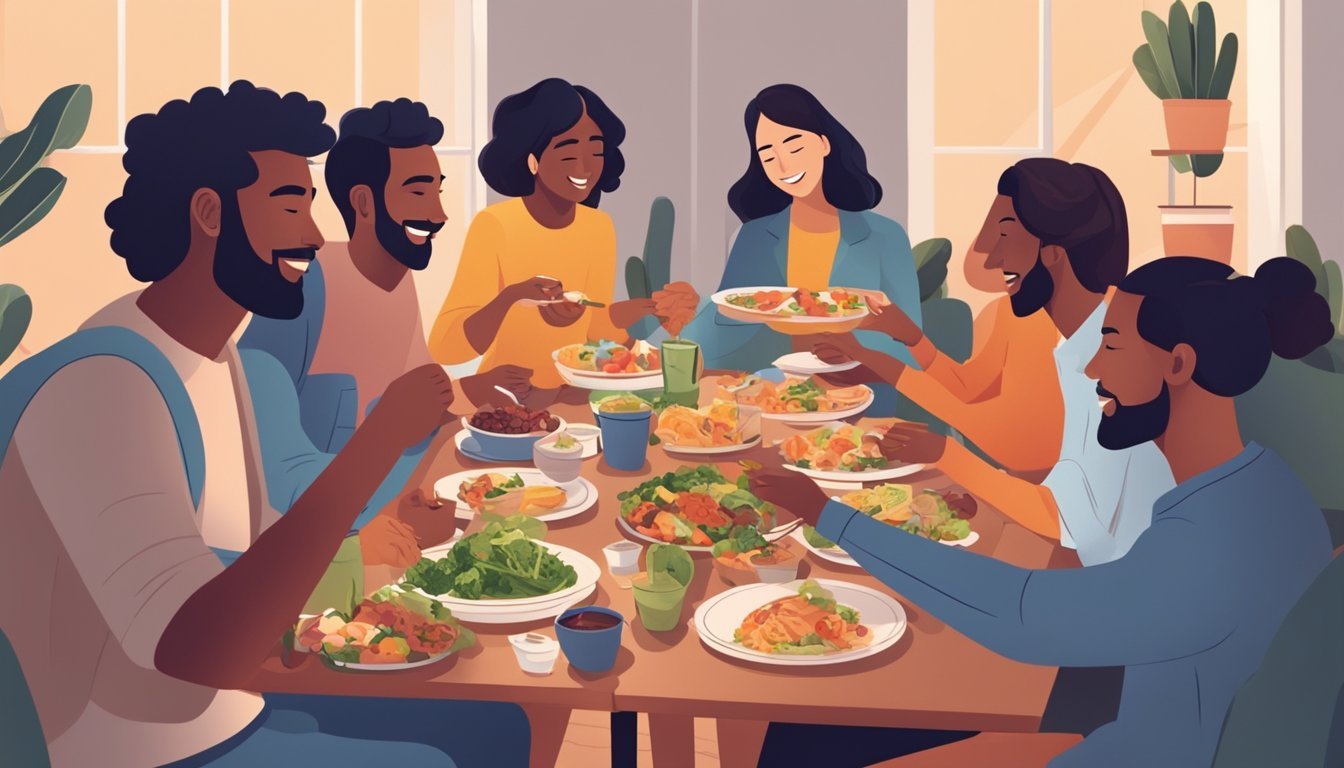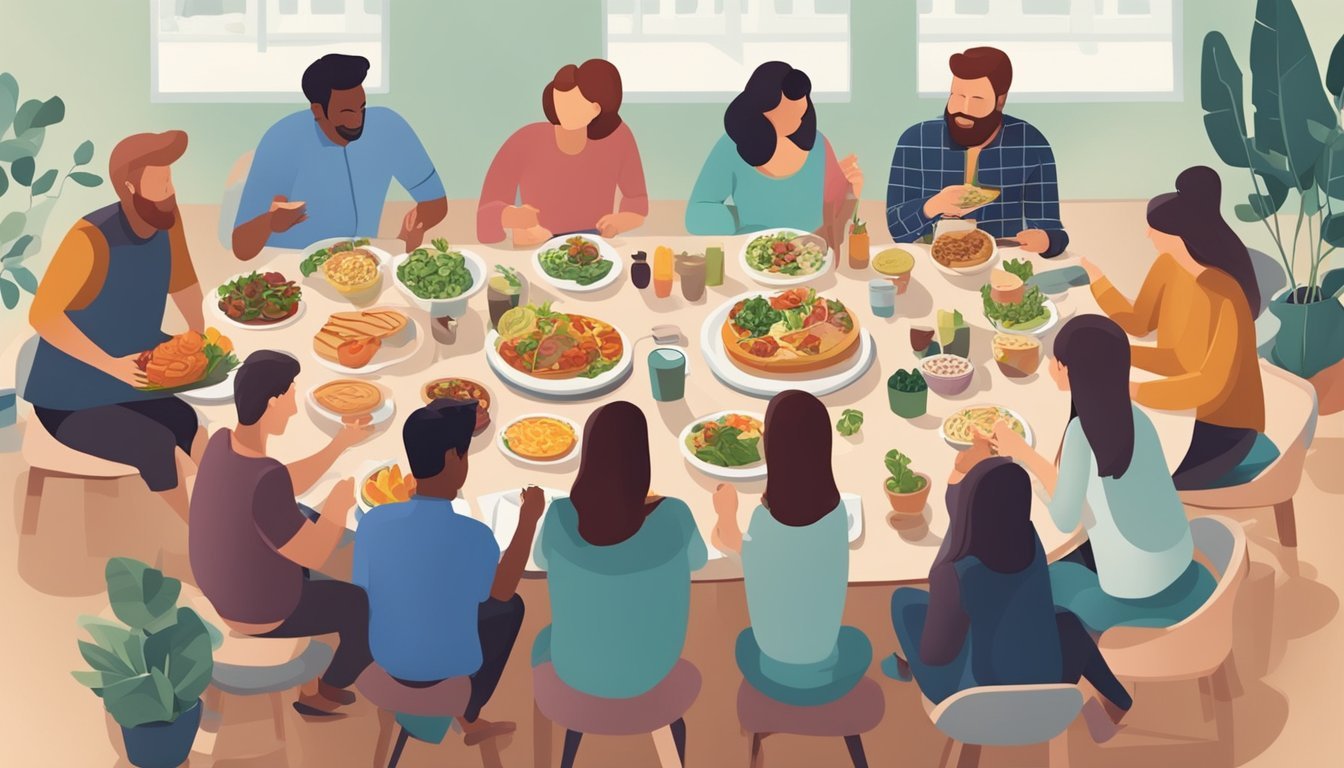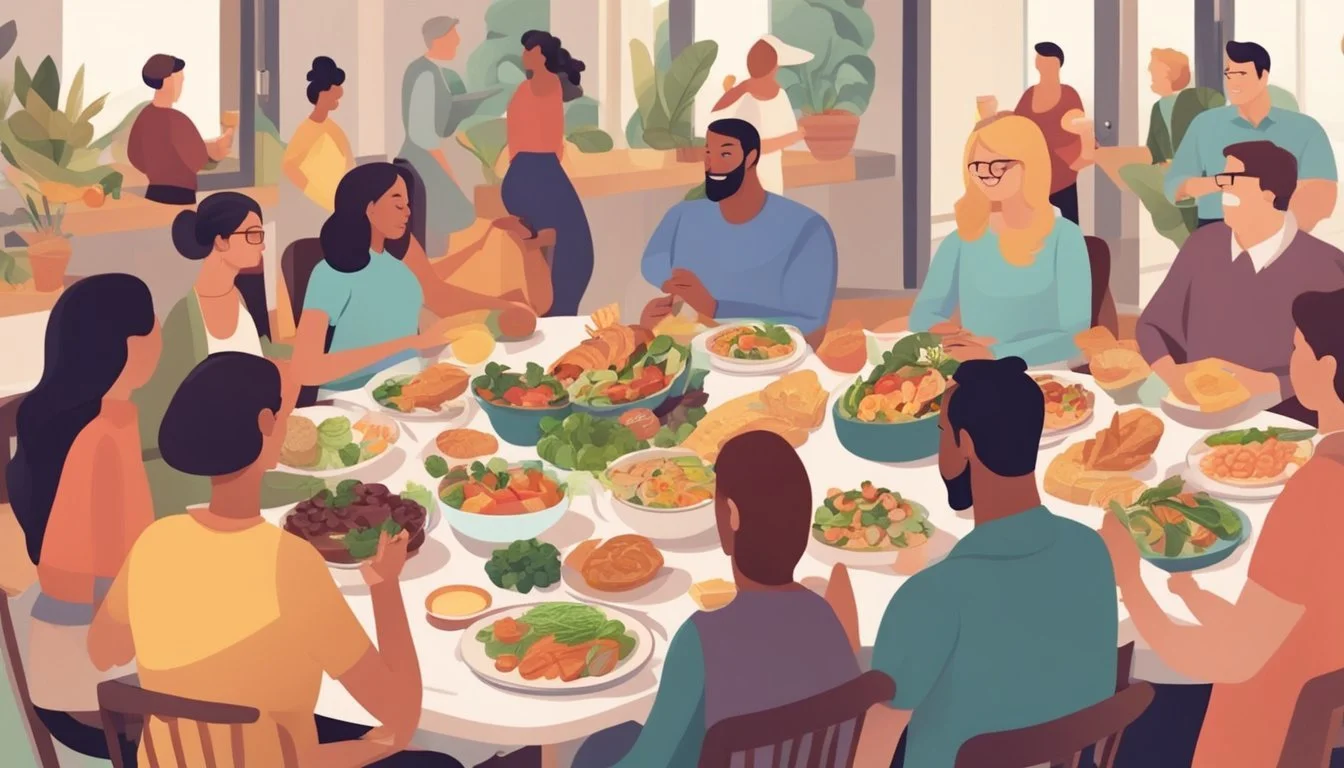Keto Diet: Managing Social Situations and Navigating Peer Pressure
Embarking on a keto diet can be a transformative experience, providing a plethora of health benefits ranging from weight loss to improved blood sugar regulation. As individuals adapt to this high-fat, low-carbohydrate diet, the body shifts into a state known as ketosis, where it burns fat for energy more efficiently. Despite the personal benefits, adhering to the keto diet can prove challenging in social settings where food plays a central role in gatherings and celebrations.
Navigating the terrain of social situations while maintaining a keto lifestyle requires planning and communication. Whether dining out with friends or attending a family dinner, individuals following the keto diet often face menu options that don't align with their dietary restrictions. Addressing these scenarios confidently and knowledgeably ensures that diet adherence does not become a source of stress or social friction.
It is possible to thrive socially on a keto diet by employing strategies such as suggesting keto-friendly venues, bringing one's own dishes to share, or focusing conversations on the positive personal impacts of the diet rather than the restrictions it imposes. As keto becomes increasingly popular, social acceptance is growing, and with the right approach, it can be seamlessly integrated into one's social life.
Understanding the Keto Diet
Before diving into the specifics, it's essential to recognize that the ketogenic, or keto, diet focuses on high-fat, low-carb foods to promote ketosis—a metabolic state conducive to fat burning and energy production.
Principles of Ketogenic Lifestyle
The ketogenic lifestyle is structured around the core principle of macronutrient adjustment: reducing carbohydrate intake to typically 20-50 grams per day and significantly increasing dietary fat. This shift moves the body from relying on glucose for energy to utilizing fat, leading to the production of ketones in the liver.
Key Macronutrient Ratios for a Ketogenic Diet:
70-80% of calories from fat
10-20% of calories from protein
5-10% of calories from carbohydrates
Benefits of a High-Fat, Low-Carb Diet
Adherents of the ketogenic diet may experience various benefits, mainly centered on weight loss goals and glycemic control. A ketogenic, high-fat diet can also improve satiety and reduce overall calorie intake. Furthermore, it may offer therapeutic potential for neurological disorders, though more research is needed to fully understand these effects.
Ketosis and Energy Levels
Ketosis is the hallmark of the ketogenic diet, where the body uses ketones for energy instead of glucose. By restricting carbs, the body is forced to turn to fat stores, resulting in weight loss. Ketosis is typically achieved after a few days of low carbohydrate intake and can lead to a state of enhanced mental clarity and sustained energy levels, as fat provides a more stable source of fuel than the quick spikes from glucose.
Note: The information presented here should be used as a starting point and individuals should consider consulting healthcare professionals before starting a new dietary regimen.
Navigating Social Situations
When adhering to a ketogenic lifestyle, social situations can pose challenges that require careful communication and strategic planning to navigate successfully.
Challenges of Keto in a Social Context
Social gatherings often feature a variety of foods not suitable for a ketogenic diet, leading to scenarios where dietary restrictions must be managed. Individuals may face social anxiety when surrounded by non-keto options or feel pressured to justify their dietary choices, which can strain social dynamics.
Communication and Dietary Choices
Effective communication is key in social situations. Briefly explain the essence of a keto diet and its importance to your health and well-being. Practice a short, relatable explanation, no longer than a few sentences, to ease any questions that may arise. Emphasize how the diet benefits you personally and avoid complex nutritional jargon. For instance:
"I follow a keto diet for better energy and focus."
"I find that I feel my best avoiding sugars and starches."
Planning Ahead for Social Events
Preparing for social events dramatically increases the chances of maintaining a ketogenic lifestyle. Strategies include:
Plan Meals: Review the menu ahead of time and identify keto-friendly options. If uncertain, contact the host or restaurant.
BYOF: Bring your own food if it's acceptable—consider a dish that both you and others can enjoy.
Keto Snacks: Pack snacks to curb hunger and avoid temptations—nuts, cheese, or olives are portable and discreet.
Beverage Choices: Sip on keto-friendly beverages such as water, tea, or coffee, and if you choose to drink alcohol, opt for spirits with unsweetened mixers.
By employing these tactics, individuals can enjoy social events without compromising their ketogenic dietary choices.
Dietary Strategies for Gatherings
Navigating social gatherings while maintaining a ketogenic lifestyle requires planning and understanding of suitable options that align with low-carb, high-fat dietary principles.
Eating Out on a Keto Diet
When dining out, individuals should review the restaurant menu ahead of time when possible to identify low-carb options. They can also request modifications to dishes, such as substituting starchy sides with vegetables. Communicating clearly with the server about dietary preferences ensures that one's ketogenic lifestyle is accommodated.
Menu Strategies:
Look for grilled proteins like chicken or fish.
Opt for salads with olive oil or vinaigrette dressing.
Avoid breaded or sugary items.
Dealing with Alcoholic Beverages
Alcohol consumption should be approached with caution, as many alcoholic beverages contain hidden sugars. Choices should be limited to spirits with zero-carb mixers or dry wines. People may also decide to abstain or bring their own low-carb alcoholic beverages if the host permits.
Alcohol Selection:
Choose clear spirits like vodka or gin with a calorie-free mixer.
Select dry wines over sweeter varieties.
Keto-Friendly Food for Parties and Potlucks
Those attending events with a potluck format benefit from bringing their own food that fits within their dietary restrictions, ensuring there's at least one keto-friendly dish available. Preparing a sizable portion allows one to share with others, which can also serve as a conversation starter about their dietary choices.
Potluck Ideas:
Bring a meat and cheese platter.
Prepare a low-carb casserole or veggie dish.
Healthy Keto Eating
Maintaining a healthy keto diet requires careful selection of foods to ensure nutrient density, avoiding potential diet triggers, and, for some, incorporating intermittent fasting. These strategies will help individuals adhere to a keto lifestyle while navigating social situations.
Selecting Nutrient-Dense Foods
On a ketogenic diet, the emphasis is on nutrient-dense foods to provide the body with essential vitamins and minerals. Key components include:
Vegetables: Leafy greens like spinach and kale, and above-ground vegetables such as broccoli and cauliflower, are low in carbs and high in fiber.
Proteins: Choices like grass-fed beef, wild-caught fish, and free-range chicken are optimal.
Fats: Healthy fats from sources such as avocados, olive oil, and coconut oil are crucial.
Seeds and nuts: Chia seeds, flaxseeds, almonds, and walnuts offer healthy fats and fiber but should be consumed in moderation due to their caloric density.
Cheese and dairy: Full-fat cheeses are good in moderation, offering both fat and protein with minimal carbs.
Berries: While most fruits are high in carbs, berries like raspberries and blackberries can be enjoyed in small amounts.
Avoiding Common Keto Diet Triggers
Individual triggers can lead to overconsumption or poor food choices. Here are key triggers to be mindful of:
Hidden sugars: Read labels to avoid sugars masquerading under different names, which can spike blood sugar levels.
High-carb foods: Steer clear of foods that can disrupt ketosis, such as bread, pasta, and sugary snacks.
Mindful eating: Pay attention to hunger cues and emotional eating triggers, which can lead to breaking keto protocols.
One should be particularly vigilant in social situations where non-keto foods are abundant. Planning and preparedness can help avoid these triggers.
Incorporating Intermittent Fasting
Intermittent fasting (IF) can complement a ketogenic diet by:
Enhancing fat-burning: IF may increase ketone production, promoting greater fat loss.
Improving blood sugar control: It can help regulate blood sugar levels, benefiting overall metabolic health.
Individuals may choose different IF approaches, such as the 16/8 method (16-hour fast with an 8-hour eating window) or 24-hour fasts a couple of times a week. However, one should approach intermittent fasting carefully, ensuring it aligns with their health goals and physician's advice.
Keto Diet in Different Settings
Adhering to a ketogenic lifestyle requires careful consideration of food choices, particularly during social events, work functions, and travel. Navigating these settings on a keto diet is achievable with preparation and communication.
Holidays and Special Occasions
During holidays and special occasions, those on a keto diet face abundant temptations in the form of carb-heavy dishes and sugary desserts. It's beneficial for individuals to:
Plan ahead by bringing keto-friendly dishes to share, ensuring they have suitable options.
Communicate preferences gently to hosts, possibly offering to assist with the menu.
Professional Environments and Work Events
In professional environments and work events, one may encounter catered lunches or networking events where the food options are not keto-friendly. To stay on track, individuals can:
Inform organizers in advance about dietary restrictions to request specific foods.
Opt for safe choices such as salads with olive oil, proteins without sauces, and cheese platters.
Travel and Vacationing on Keto
Travel and vacationing on Keto presents its unique set of challenges, from airport food courts to local dining. Maintaining a ketogenic diet while traveling is manageable with the following steps:
Research restaurants and menus ahead of time to find locations that cater to keto dietary needs.
Pack keto snacks for easy access during trips, such as nuts, cheese, and hard-boiled eggs.
Keto-Friendly Alternatives and Substitutions
Adopting a ketogenic lifestyle involves a paradigm shift in one's dietary choices, specifically in finding keto-friendly options to replace traditional high-carbohydrate foods. This section provides specific strategies for creating personalized keto menus and discovering suitable substitutes.
Creating Your Own Keto Menu
When designing their keto menu, one should focus on including a variety of keto-friendly snacks and meals rich in fats that align with the ketogenic diet's macronutrient distribution. A customary keto dinner might feature a protein source, like grilled chicken or fish, accompanied by a generous portion of leafy greens dressed with olive oil. For dessert, they could opt for a serving of berries with a dollop of unsweetened whipped cream, keeping within their carbohydrate limits.
Finding Substitutes for Non-Keto Foods
Keto practitioners often seek staple substitutions for everyday items that are not keto-compliant due to their high carbohydrate content. Here is a table of common foods and their keto-friendly alternatives:
Non-Keto Food Keto Substitute Net Carbs (Per Serving) White rice Riced cauliflower Less than 3 grams Pasta Zucchini noodles (zoodles) 3-4 grams Bread Almond flour or coconut flour bread 2-3 grams Soda/beer Sparkling water with lemon slice 0 grams Sugar (in recipes) Stevia, erythritol, or monk fruit sweetener 0-1 grams
It's crucial for individuals to customize their dietary choices to maintain a true ketogenic diet while still enjoying a variety of foods. For beverages, they might select water, coffee, or tea without sugar, and infuse it with flavorings like cinnamon or vanilla for an enhanced taste experience. Desserts can be reinvented using ingredients such as almond flour and unsweetened cocoa to craft satisfying keto recipes.
By carefully selecting alternatives and crafting personalized keto-friendly meals, individuals can adhere to the restrictive aspects of a ketogenic diet without sacrificing flavor or variety.
Social Aspects of Keto Dieting
When navigating the social aspects of keto dieting, individuals should focus on building a robust support system, clearly communicating their dietary restrictions, and integrating their keto lifestyle into their social life with minimal friction.
Building a Support System
One's support system plays a pivotal role in managing the social aspects of a ketogenic diet. Family and friends can offer encouragement and accommodate dietary preferences during social gatherings. It is helpful for individuals to educate their close circle about the ketogenic diet, emphasizing not only the foods that are off-limits but also the variety of keto-friendly options they can enjoy together. For instance, an individual might suggest a potluck-style gathering where everyone brings a dish, making it easier to include keto-friendly choices without imposing on the host.
Expressing Your Keto Choices
Communication is essential when expressing dietary restrictions in social settings. Individuals on the ketogenic diet should prepare a concise "elevator speech" to explain their dietary choices when questioned. This speech should be brief, factual, and delivered without sounding apologetic. For example, one might say, "I am following a ketogenic diet for health reasons, which means I generally avoid sugars and starches." Additionally, when invited to an event, it can alleviate social anxiety and ensure peace of mind by informing the host of one's dietary restrictions ahead of time.
Keto and Your Social Life
To prevent the ketogenic diet from becoming a socially restrictive experience, individuals should plan ahead for social events. This might involve reviewing a restaurant's menu online beforehand to identify keto-friendly options or eating a small, satisfying meal before attending a party to avoid hunger-driven temptations. Sleep is also crucial; a lack of sleep can undermine willpower and make sticking to dietary choices more challenging during social interactions. Therefore, maintaining a good sleep schedule is essential to manage one's diet confidently in social settings.
Keto-Friendly Recipes and Treats
Crafting a menu that’s both appealing and keto-compliant can seem challenging, but with a selection of savory dishes, indulgent desserts, and refreshing beverages, social gatherings can cater to the keto lifestyle with ease.
Savory Dishes for Social Gatherings
One can navigate social gatherings with keto-friendly options like Cheese and Nut Platters - an assortment of cheeses paired with a variety of nuts provide a satisfying and simple snack. Guacamole serves as a flavorful dip that pairs well with low-carb keto bagels (how long do bagels last?) or vegetable sticks. For heartier options, a Cauliflower Bake or a Savory Pie filled with meats and keto-approved vegetables can take center stage as an enticing main dish. Additionally, mini Quiches made with a low-carb crust offer a convenient and delicious bite-sized treat.
Cheese: Cheddar, Brie, Gouda
Nuts: Almonds, Walnuts, Pecans
Main Dishes: Quiche, Savory Pie, Cauliflower Bake
Decadent Keto Desserts
Desserts on a ketogenic diet can be both decadent and guilt-free. Cheesecake Fat Bombs and Almond Cake Fat Bombs provide a rich, creamy texture and can satisfy the sweet tooth without breaking the carb budget. For chocolate lovers, Chocolate Peanut Butter Brownies deliver the classic flavors without the added sugars. And for a lighter touch, Vanilla Cupcakes or Sweet Bread made with almond or coconut flour can indulge cravings for baked goods.
Fat Bombs: Cheesecake, Almond Cake
Bakery Delights: Vanilla Cupcakes, Sweet Bread
Brownies: Chocolate Peanut Butter
Refreshing Keto Beverages
To compliment the meal, refreshing Keto-Friendly Beverages ensure that everyone can toast to good health. Options range from infused waters to a rich, homemade almond milk. Those looking for something a bit more festive might opt for a sparkling seltzer with a twist of citrus. These drink choices keep the carb count low while providing enjoyable, tasteful options to hydrate and celebrate.
Cold Drinks: Infused Water, Sparkling Seltzer
Hot Drinks: Homemade Almond Milk
Adapting Keto for Long-Term Success
The ketogenic lifestyle necessitates commitment and adaptability, especially when navigating social situations. Strategizing to maintain the health benefits and weight loss achieved through keto is essential for sustained success.
Adopting Keto as a Sustainable Lifestyle
To make the keto diet sustainable, an individual must integrate it seamlessly into their daily regimen. This includes adapting favorite recipes to fit ketogenic guidelines and planning meals in advance. Social situations require anticipation; they can either bring their own food (BYOF) to gatherings or communicate dietary restrictions clearly to hosts.
Meal Plans
Breakfast: Keto pancakes with almond flour
Lunch: Caesar salad with grilled chicken, minus croutons
Dinner: Zucchini noodles with meatballs in low-carb marinara sauce
Social Tips
Communicate dietary preferences proactively.
Offer to bring a keto-friendly dish to share.
Maintaining Weight Loss and Health Benefits
The key to preserving the weight loss and health benefits of keto is consistent practice and avoiding carb-heavy temptation in social settings. It's important to recognize personal triggers and have strategies to navigate these. Staying in ketosis is crucial, so snacking on keto-friendly options like cheese or nuts can help maintain this metabolic state.
Strategies for Success
Identify and prepare for personal triggers.
Keep a stock of keto snacks, such as macadamia nuts or cheese sticks.
Continual Learning and Keto Education
Long-term keto adherence is reinforced by continually updating knowledge about the diet. Advancements in nutrition science can offer new insights into ketogenic living. They should educate themselves on the latest findings and adapt their approach accordingly, ensuring their diet remains effective and beneficial.
Educational Resources
Read the recent literature on keto and nutrition science.
Subscribe to keto lifestyle blogs or communities for new ideas and support.
By incorporating these strategies, an individual can navigate the keto lifestyle adeptly, ensuring long-term success while enjoying the social aspects of eating and living healthfully.








